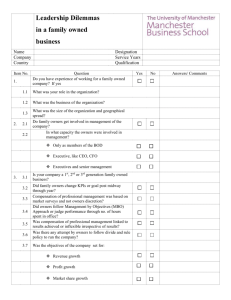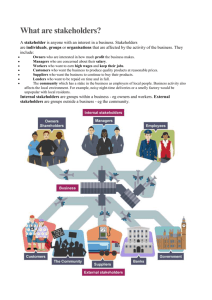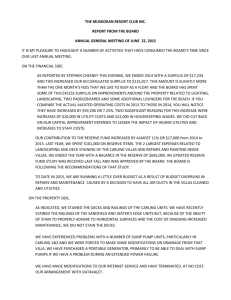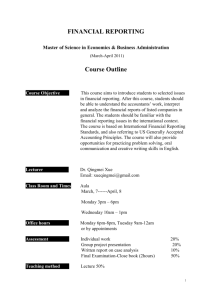Local common property
advertisement
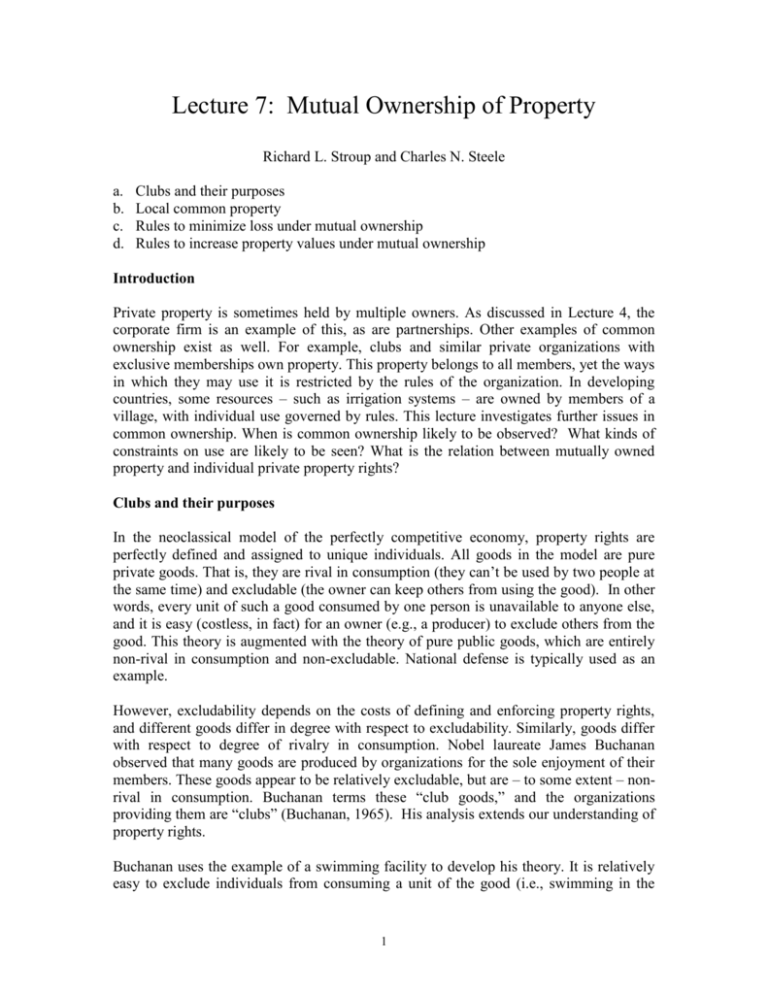
Lecture 7: Mutual Ownership of Property Richard L. Stroup and Charles N. Steele a. b. c. d. Clubs and their purposes Local common property Rules to minimize loss under mutual ownership Rules to increase property values under mutual ownership Introduction Private property is sometimes held by multiple owners. As discussed in Lecture 4, the corporate firm is an example of this, as are partnerships. Other examples of common ownership exist as well. For example, clubs and similar private organizations with exclusive memberships own property. This property belongs to all members, yet the ways in which they may use it is restricted by the rules of the organization. In developing countries, some resources – such as irrigation systems – are owned by members of a village, with individual use governed by rules. This lecture investigates further issues in common ownership. When is common ownership likely to be observed? What kinds of constraints on use are likely to be seen? What is the relation between mutually owned property and individual private property rights? Clubs and their purposes In the neoclassical model of the perfectly competitive economy, property rights are perfectly defined and assigned to unique individuals. All goods in the model are pure private goods. That is, they are rival in consumption (they can’t be used by two people at the same time) and excludable (the owner can keep others from using the good). In other words, every unit of such a good consumed by one person is unavailable to anyone else, and it is easy (costless, in fact) for an owner (e.g., a producer) to exclude others from the good. This theory is augmented with the theory of pure public goods, which are entirely non-rival in consumption and non-excludable. National defense is typically used as an example. However, excludability depends on the costs of defining and enforcing property rights, and different goods differ in degree with respect to excludability. Similarly, goods differ with respect to degree of rivalry in consumption. Nobel laureate James Buchanan observed that many goods are produced by organizations for the sole enjoyment of their members. These goods appear to be relatively excludable, but are – to some extent – nonrival in consumption. Buchanan terms these “club goods,” and the organizations providing them are “clubs” (Buchanan, 1965). His analysis extends our understanding of property rights. Buchanan uses the example of a swimming facility to develop his theory. It is relatively easy to exclude individuals from consuming a unit of the good (i.e., swimming in the 1 pool). In this case, any person wishing to consume a unit of the good must pay the producer (assumed to be the owner) of the good for this right. But the good also exhibits a degree of non-rivalry in consumption. More than one person can swim in the pool at any given time without reducing the others’ enjoyment, up to the point where crowding occurs. And since a pool may be used throughout the day, the number of users may be quite large without inducing crowding. Hence, up to a point, the good exhibits nonrivalry in consumption. At the same time, a swimming pool is very costly to provide. An average individual might not be able to build one for himself. However, by pooling their funds, a number of individuals might easily be able to build a facility. The result is that individuals could form an organization, a club, that builds, owns, and operates the pool. Having built the pool, the club will also have to develop rules governing its use by individual members, in order to avoid overcrowding and abuse of membership. The club may choose to limit membership, since too many members may bring overcrowding and similar problems. In short, the club makes tradeoffs between the size of facility it can afford (which increases with membership) and crowding and similar governance problems (which also increase with membership). Buchanan further notes a prediction of his model: As average income increases, the number of goods provided as club goods should increase, because as income increases, so does one’s ability to provide goods for oneself. A club good may be provided by a private club, but it also could be provided by a private firm or by a local government. (A club good is somewhat similar to a local public good – i.e., a public good that is subject to crowding, or rivalry in consumption, after a point.) How a club good is provided – and whether it is provided at all – depends in part upon the overall institutional framework, i.e., the basic property rights and related rules, such as rules governing contracts and enforcement. In an environment in which individuals are relatively free to write contracts and enforce them, one is likely to see a variety of different arrangements for providing club goods existing side-by-side: clubs, profitmaking firms, and local governments. Different forms of ownership may have different characteristics regarding the quality of the good provided, the rules for use, the costs of providing the good, etc. Individuals will likely experiment with different forms of ownership, given the freedom to do so. (See Lecture 8 on entrepreneurship and institutions.) Local common property Local common property provides another example of mutual ownership of goods. With such goods, exclusion is extremely costly, but consumption is rival. Goods of this nature can include such things as inshore fisheries, forests, irrigation systems, pastures, etc., depending on the costs of excluding in any particular case. In such a case, property is likely to be held in common by all those who use it. If, in addition, consumption reduces the quantity of the good available (as fishing does), the danger arises that the good will be 2 overused, and hence harmed or even destroyed. Since the destruction of the common property is not in any user’s interest, an incentive exists to design and enforce rules governing its use. The problem is that the rules must develop enforceable exclusion where little or none exists. (See Lecture 9 for a detailed discussion of the problems of common property, the “tragedy of the commons.”) Rules governing the use of common property can be more easily established when users (that is, owners) of the common property have similar interests. Hence, successful governance of common property is more likely to be found with homogeneous users. Similarly, costs of establishing and enforcing mutually acceptable rules increase with the number of owners. Paul Seabright (1993) summarizes some basic issues involved in developing such rules. Suppose that it is prohibitively costly to exclude users from fishing in a pond. Too much fishing will destroy the pond for everyone, but a limited amount of fishing will permit every owner to enjoy fish into the indefinite future. If they place sufficient value on future fishing relative to fishing in the present, the group of owners might agree to voluntarily restrict their own fishing. Unfortunately, once such an agreement is made, it cannot be enforced – as we have stated, exclusion is prohibitively costly. However, even under such circumstances, groups of owners might sustain the rules by voluntarily obeying them. Since each individual gains from the rules being followed, and rule-following behavior will collapse if cheating develops, the owners may be able to sustain cooperation to keep the rules in effect. Such a system is even more likely to work when there exists some limited ability to enforce exclusion, e.g., by punishing those who break the rules. Also, the rules must include some way of limiting membership, since for each additional member the value of the property to each member declines. Such a system typically involves reputation and trust. If individuals are able to place trust in each other, or establish reputations for reliable behavior, then governance of the common property will be easier – the costs of enforcement are reduced. Again, successful governance of common property is easier with smaller, more homogeneous groups, ceteris paribus. Willingness to voluntarily commit to following mutually agreed upon rules, and the ensuing factors of trust and reputation, lower transaction costs in all settings, of course – not only in the case of local common property. 3 The rules for governance of the commons actually establish de facto private property rights, in that they assign to each individual the share of the good he may consume. Interestingly, if a successful system for governance of a local common property is established, it is possible that subsequent de jure privatization of the commons may actually lead to the overuse that was averted under common ownership (Seabright, 1993). This might occur where exclusive rights are established over only one dimension of the common property, where assigning rights shifts the relative bargaining strengths of the parties involved, or where new owners appear who have no understanding of the current ownership rules. For example, consider a forest in an undeveloped country. It might be managed as common property by all members of a village, and used as a source of food and firewood. Suppose the central government reassigns rights to logging to an outside party, ignoring the villagers’ de facto property rights. Introducing a single large player can cause the entire system of voluntary compliance with the rules to break down, leading everyone to overuse the resource, attempting to get a share before it is destroyed. Of course, if private property rights are established completely, such an outcome would not occur, but property rights are never complete. In this case, what appears (to the government) to be un-owned property is actually property owned under a complex system of governance. Establishing private property in one dimension can destroy it in others. Rules governing mutually owned property With a privately owned good, the owner may simply use it as he pleases. Mutual ownership of property requires rules governing owners’ behavior. These rules will be designed to maximize the value of the resource to the owners, subject to the costs of establishing and enforcing the rules. Rules will limit the number of owner-users and the intensity of use. Also, rules will define what each owner must contribute to the upkeep of the resource. Ostrom and Gardner (1993) examine the case of common-property irrigation systems in less developed countries. Typically, such systems require input of labor from farmers, and means of determining water allocations to farmers. Ostrom and Gardner compare farmer-managed systems with government-managed systems in Nepal. They find that farmer-managed systems tend to give much more even distributions of water to farmers than do government-managed systems, particularly with respect to “headend” (farther upstream) users vs. “tailend” (farthest downstream) users. Farmer-managed systems are developed on the basis of intensive negotiations among farmers, with substantial effort put into assigning labor duties of each and the rules for utilizing water. These systems typically make investments, such as lined canals and betters systems of ditches, that tend to give relatively equal shares of water to headend and tailend users. This is a consequence of the need to reach mutually agreeable decisions. Government-managed systems, on the other hand, typically invest more heavily in headworks, such as diversion dams, that are seen as “modern.” Often the funding is development aid from external sources. Government managers tend to have less interest 4 in developing subsequent canal systems. Similarly, given the “gift” of a permanent headworks, headend farmers have little incentive to cooperate with downstream farmers. The result is that government-managed systems tend to be less effective in delivering water at all levels, tailend and headend. The loss of gains from cooperation reduces net income. The characteristics of the good under consideration help to determine the rules that will maximize the value to owners. For example, in the United States, some apartment buildings are owned in common by the owners of the apartments. One form of ownership is the condominium (condo) while another is the cooperative (co-op). In both cases, each unit (apartment) has a single owner; in addition, all of the owners together share ownership of common areas of the building and participate in an owners’ association that oversees rules for use and upkeep of the building and grounds. These arrangements tend to give owners more control over buildings than they would have renting from a landlord (or a firm), which is the most common arrangement. Condo and co-op arrangements are more likely to appeal to those who have particular tastes and desire a measure of increased control over their living areas. However, the two forms differ regarding membership. In a condo arrangement, an individual owner may sell his condominium to anyone he wishes. In a co-op, he may only sell to persons approved by the other owners, who vote on the issue. What determines which form of ownership is used? Co-ops clearly appeal to those who are more selective about their neighbors. Condominiums tend to be large, with substantial space, in relation to co-ops. It may be that selectivity is less important when people are less crowded together. There are several lessons from the study of mutually owned property. First, a view of property rights as either nonexistent, or completely exclusive and individual, is too simple. Even when exclusion is possible, there may be reasons for some property to be held in common. Second, in such cases, rules must be developed to govern the use of the property. These rules define the ownership rights and duties. Third, the enforcement of the rules depends on costs, and may range from informal agreements, established by trust and held together by reputation, to third party enforcement of contracts. Fourth, given that individuals have freedom to exchange property rights and experiment with different kinds of contractual arrangements, numerous kinds of ownership will be seen for similar goods in the same society. This is because differing forms of ownership yield different streams of benefits and costs to owners. Thus different forms can be matched to owners’ preferences and ability to pay. REFERENCES Buchanan, J. 1965. “An Economic Theory of Clubs.” Economica 32(1) pp. 1-14. Ostrom, E. and R. Gardner. 1993. “Coping with Asymmetries in the Commons: SelfGoverning Irrigation Systems Can Work.” Journal of Economic Perspectives 7(4): pp. 93-112. 5 Seabright, P. 1993. “ Managing Local Commons: Theoretical Issues in Incentive Design.” Journal of Economic Perspectives 7(4): pp. 133-134. 6


